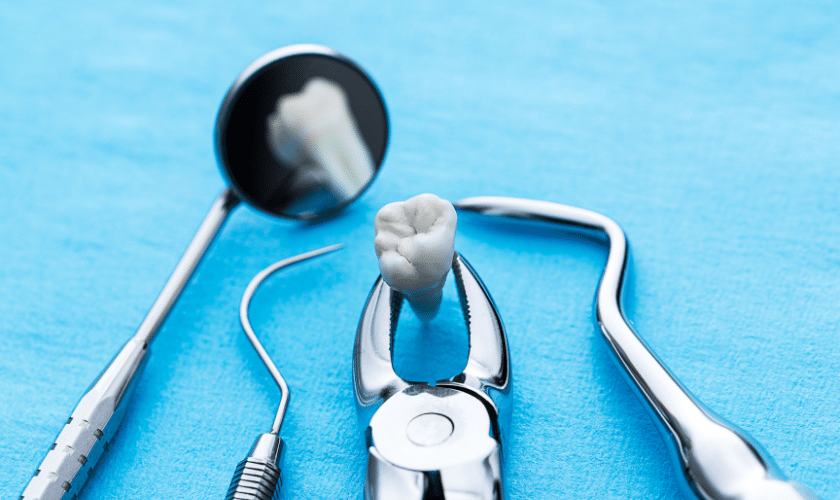
Say goodbye to tooth pain and discomfort with the ultimate guide to tooth extraction! Whether you’re facing a problematic wisdom tooth or need to make room for orthodontic treatment, understanding the ins and outs of this common dental procedure is essential. From types of extractions to aftercare tips, we’ve got you covered with all the information you need for a smooth and successful experience. So let’s dive in and discover everything there is to know about the tooth extraction process – because taking care of your oral health has never been easier!
Understanding The Need For Tooth Extraction
When it comes to dental health, prevention is always the best approach. However, there are times when tooth extraction becomes necessary. One common reason is severe tooth decay that cannot be effectively treated with a filling or root canal therapy. In such cases, removing the affected tooth can prevent further damage and infection.
Another reason for tooth extraction is overcrowding in the mouth. This often occurs when wisdom teeth start to erupt, and there isn’t enough space for them to properly align with existing teeth. The misalignment can lead to pain, shifting of other teeth, and even infections.
In some instances, extracting a tooth may also be recommended before undergoing orthodontic treatment. By creating extra space in the jawline, braces or aligners can work more efficiently in straightening your smile.
Additionally, individuals who have weakened immune systems due to certain medical conditions may require extractions if they develop an oral infection that poses a risk to their overall health.
It’s important not to ignore any signs of pain or discomfort in your mouth, as they could indicate underlying issues that might necessitate tooth extraction. Regular dental check-ups will help detect problems early on and allow your dentist to recommend appropriate treatments before things worsen.
Types Of Tooth Extractions

When it comes to tooth extractions, there are two main types: simple and surgical. Simple extractions are performed on teeth that are visible in the mouth and can be easily accessed by the dentist. This type of extraction is typically done using local anesthesia to numb the area around the tooth.
On the other hand, surgical extractions are more complex and involve removing teeth that may have broken off at the gum line or have not fully erupted. These extractions often require an incision into the gum tissue to access and remove the tooth. In some cases, bone may need to be removed as well.
Additionally, impacted wisdom teeth often require surgical extraction due to their position at the back of the mouth and lack of space for proper eruption. Wisdom teeth removal is a common dental procedure, usually done under general anesthesia.
Regardless of which type of extraction you undergo, it’s important to follow your dentist’s instructions for post-operative care to ensure proper healing. This may include avoiding certain foods or activities that could dislodge blood clots or cause irritation in the extraction site.
Understanding different types of tooth extractions can help alleviate any concerns you may have about undergoing this procedure. Whether it’s a simple extraction or a more complex surgical one, rest assured knowing that dentists take every necessary precaution to ensure a safe and comfortable experience for their patients.
Preparing For A Tooth Extraction
Before undergoing a tooth extraction, it is important to prepare yourself properly, both physically and mentally. Here are some essential steps to take in order to ensure a smooth experience.
Make sure to inform your dentist about any medical conditions or medications you may be taking. This will allow them to determine if there are any potential risks or complications during the procedure.
Next, it is crucial to follow any pre-extraction instructions given by your dentist. This may include avoiding certain foods or beverages prior to the appointment, as well as refraining from smoking or using tobacco products.
Additionally, arrange for someone to accompany you on the day of the extraction. Having a support system can help alleviate anxiety and provide transportation after the procedure if needed.
Furthermore, consider discussing pain management options with your dentist beforehand. They may recommend over-the-counter pain relievers or prescribe medication depending on the complexity of the extraction.
Prepare post-extraction supplies such as gauze pads and ice packs at home so that they are readily available for immediate use once you return from the dental office.
By following these preparation tips, you can ensure that your tooth extraction process goes smoothly and minimize any potential discomfort throughout the recovery period.
The Tooth Extraction Procedure
The tooth extraction procedure is a fairly common dental procedure that involves the removal of a tooth from its socket. While it may sound intimidating, modern dentistry has made this process safe and relatively painless.
Before the actual extraction begins, your dentist will first numb the area around the tooth with local anesthesia to ensure you don’t feel any discomfort during the procedure. In some cases, sedation may also be used to help patients relax.
Once you’re numbed and comfortable, your dentist will use specialized instruments to loosen and remove the tooth from its socket carefully. Sometimes, depending on the complexity of the case or if multiple teeth are being extracted at once, an oral surgeon may be involved in performing this procedure.
Afterward, your dentist will provide instructions on how to care for your mouth post-extraction. This typically includes avoiding hard or chewy foods for a few days and gently rinsing with salt water to promote healing.
It’s important to note that every patient’s experience with tooth extractions can vary based on factors like overall health, age, and complexity of the extraction itself. But by following your dentist’s aftercare instructions closely and maintaining good oral hygiene practices throughout recovery, you’ll increase your chances of a smooth healing process.
Remember that while temporary discomfort is normal after an extraction, if you experience severe pain or excessive bleeding that doesn’t subside within 24 hours, it’s crucial to contact your dentist immediately for further evaluation.
The tooth extraction procedure involves removing a damaged or problematic tooth under local anesthesia. It is generally safe and painless when performed by a skilled professional. Following proper aftercare guidelines provided by your dentist can help ensure smooth healing and minimize complications. If any concerns arise during recovery, such as severe pain or excessive bleeding beyond what is considered normal, it’s essential to seek immediate dental attention for appropriate treatment.
Aftercare Tips For A Smooth Recovery
Taking care of yourself after a tooth extraction is crucial for ensuring a smooth and speedy recovery. Here are some helpful tips to follow:
1. Follow your dentist’s instructions: Your dentist will provide specific post-extraction instructions tailored to your individual needs. It’s important to carefully follow these guidelines, as they will help prevent complications and promote healing.
2. Rest and take it easy: After the procedure, make sure to rest and give yourself time to recover. Avoid strenuous activities that cause discomfort or disrupt the healing process.
3. Apply ice packs: To reduce swelling and minimize pain, you can gently apply ice packs or cold compresses to the affected area in intervals of 10-15 minutes on and off.
4. Take prescribed medication: Your dentist may prescribe pain relievers or antibiotics following the extraction. Be sure to take them as directed to manage any discomfort and prevent infection.
5. Maintain oral hygiene: While it’s essential not to rinse your mouth vigorously immediately after the extraction, you should continue brushing your teeth gently twice a day with a soft-bristled toothbrush, being careful around the extraction site.
6. Choose soft foods: Stick with a diet of soft foods, such as mashed potatoes, yogurt, soups, and smoothies, during the first few days after extraction. Avoid crunchy or sticky foods that can irritate the surgical site.
7. Keep hydrated: Drink plenty of fluids, but avoid using straws for at least 24 hours since suction can dislodge blood clots necessary for proper healing.
8. Support healing with saltwater rinses: Rinse gently with a warm saltwater solution (made by dissolving half a teaspoon of salt in eight ounces of warm water) multiple times a day starting from 24 hours after surgery.
Remember that everyone’s recovery process may vary slightly based on their circumstances; therefore, always consult your dentist if you have any concerns or questions. By following these aftercare tips, you can help ensure
Managing Pain and Discomfort
Dealing with pain and discomfort after a tooth extraction is an important part of the recovery process. While it’s normal to experience some level of discomfort, there are several ways you can manage and alleviate this pain.
1. Take prescribed medication: Your dentist may prescribe pain relievers to help manage any post-extraction pain. It’s essential to follow their instructions carefully and take the medication as directed.
2. Apply ice packs: Applying ice packs on your cheek near the extraction site can help reduce swelling and numb the area, providing relief from pain.
3. Use saltwater rinse: A warm saltwater rinse can be soothing for the mouth after a tooth extraction. Mix half a teaspoon of salt in eight ounces of warm water and gently swish it around your mouth for about 30 seconds before spitting it out.
4. Avoid hard or chewy foods: Stick to soft foods like soups, yogurt, mashed potatoes, and smoothies during the first few days following your tooth extraction. Avoiding hard or chewy foods will prevent unnecessary strain on the healing socket.
5. Practice good oral hygiene: Brushing your teeth gently twice a day using a soft-bristled brush is crucial for maintaining oral hygiene after a tooth extraction. Be extra careful around the surgical site to avoid disturbing blood clots or causing further irritation.
6. Don’t smoke or use straws: Smoking or using straws can hinder proper healing by creating suction that could dislodge blood clots from the socket, leading to dry sockets – an extremely painful condition.
Tooth extraction is a common dental procedure that may be necessary for various reasons. Whether it’s due to severe decay, overcrowding, or infection, extracting a tooth can help improve oral health and prevent further complications.
Understanding the need for tooth extraction and being aware of the different types available can help patients feel more informed and prepared before undergoing the procedure. By following proper aftercare instructions and seeking professional advice when needed, individuals can ensure a smooth recovery process.
While pain and discomfort are normal in the days following a tooth extraction, several steps can be taken to manage these symptoms effectively. From taking prescribed pain medications to practicing good oral hygiene habits, each person’s experience will vary slightly, but with proper care, healing should progress steadily.
Remember to consult with your dentist if you have any concerns or questions about tooth extraction or its aftercare process. They are best equipped to provide personalized guidance based on your specific situation.
While no one looks forward to having a tooth extracted, understanding the process and knowing what to expect can alleviate some anxiety surrounding this dental treatment. By prioritizing oral health care and maintaining regular visits with your dentist, you can work together towards optimal dental well-being for years to come.
Worried about cavities, gum disease, or sensitive teeth? Our Phoenix dentist at Dental Home Family Dentistry Phoenix offer comprehensive diagnosis and treatment for all your oral health concerns.


